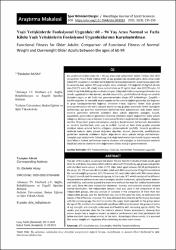| dc.contributor.author | Aksay, Ebubekir | |
| dc.date.accessioned | 2023-10-22T12:32:26Z | |
| dc.date.available | 2023-10-22T12:32:26Z | |
| dc.date.issued | 2021 | en_US |
| dc.identifier.issn | 1300-3119 | |
| dc.identifier.issn | 2667-6672 | |
| dc.identifier.uri | https://hdl.handle.net/11363/6018 | |
| dc.description.abstract | Bu çalışmanın birinci amacı 60 – 94 yaş arası yaşlı yetişkinlerin Senior Fitness Test (SFT)
sonuçlarının Vücut Kütle İndeksi (VKİ) ve yaş gruplarında cinsiyete göre, ikinci amacı elde
edilen STF sonuçlarının standart norm değerleri ile karşılaştırmasıdır. Araştırmaya yaşları 60-
94 arasında olan toplam 273 yaşlı yetişkin birey katılmıştır. VKİ değerleri 25 kg/m2 altında
olan 151 (71 kadın, 80 erkek) birey normal kilolu ve 25 kg/m2 üzeri olan 122 (70 kadın, 52
erkek) birey fazla kilolu grubunu oluşturmuştur. Çalışmada tıbbi muayene gerekmeden kısa
sürede uygulanabilen kas kuvveti, aerobik dayanıklılık, çeviklik/dinamik denge ve esneklik
ölçümleri yapan ve altı farklı test parametresinden oluşan SFT kullanılmıştır. Çarpıklık –
basıklık değerleri ile normallik analizi yapılan veriler normal dağılım gösterdiği için bağımsız
iki grup karşılaştırmasında bağımsız örneklem t-testi, bağımsız ikiden fazla grubun
karşılaştırılmasında tek yönlü varyans analizi ve yaş grupları arasındaki farkın kaynağının
belirlenmesi için post hoc testlerinden Bonferroni testi kullanılmıştır. Elde edilen veriler
esneklik gerektiren testlerde kadınların daha yüksek değerlere ulaştığını, kuvvet,
dayanıklılık, çeviklik/beceri gerektiren testlerde erkeklerin ölçüm değerlerinin daha yüksek
olduğunu, ilerleyen yaş ile beraber incelenen performans değerlerinin düştüğünü, düşüşün
özellikle 70 yaş üzeri grupta üst seviyeye ulaştığını; bacak kuvveti, kol kuvveti, dayanaklılık
ve esneklik özelliklerinde artan yaş ile birlikte normal ve fazla kilolu gruplar arasında
istatiksel olarak anlamlı farklılık olduğunu göstermektedir (p<0,05). Esneklik gerektiren
testlerde kadınlar daha yüksek değerlere ulaşırken, kuvvet, dayanıklılık, çeviklik/beceri
gerektiren testlerde erkeklerin ölçüm değerlerinin daha yüksek olduğu belirlenmiştir.
Sonuçlar yaşlı yetişkinlerin fiziksel uygunluk değerlendirmeleri için önemli ipuçları vererek,
fazla kilonun fiziksel performans üzerine olumsuz etki yaptığını ve katılımcıların testlerin
büyük bölümünde standart norm değerlerinin altında kaldığını göstermektedir. | en_US |
| dc.description.abstract | The aim of the study is to compare the Senior Fitness Test (SFT) results of older adults aged
60 to 94 with body mass index (BMI) and the obtained STF results by age groups and gender
with standard norm values. A total of 273 older adult aged between 60-94 participated in
the study. 151 (71 women, 80 men) older adult with BMI values below 25 kg/m2 constituted
the normal weight group and 122 (70 women, 52 men) older adult with BMI values above
25 kg/m2 constituted the overweight group. In the study, SFT, which consists of six different
test parameters and measures muscle strength, aerobic endurance, agility/dynamic balance
and flexibility, and can be applied in a short time without the need for medical examination
was used. Since the data analyzed for skewness - kurtosis and normality analysis showed
normal distribution, the independent sample t-test was used in the comparison of two
independent groups, one-way analysis of variance in the comparison of more than two
independent groups, and the Bonferroni test, one of the post-hoc tests, to determine the
reason of the difference in source. The data obtained show that the performance decreases
with the increasing age, the decline reaches the upper level especially in the group above
the age of 70, and there is a statistically significant difference between the groups in terms
of leg strength, arm strength, endurance and flexibility with increasing age (p <0.05). The
results give important clues for the elderly’s physical fitness assessments, showing that
excess weight has a negative impact on physical performance and that participants fall
below standard norm values in most of the tests. According to these results, it is assumed
that excess weight will negatively affect achieving standard norm values. | en_US |
| dc.language.iso | tur | en_US |
| dc.publisher | Süleyman Bulut | en_US |
| dc.relation.isversionof | https://doi.org/10.17644/sbd.833283 | en_US |
| dc.rights | info:eu-repo/semantics/openAccess | en_US |
| dc.rights | Attribution-NonCommercial-NoDerivs 3.0 United States | * |
| dc.rights.uri | http://creativecommons.org/licenses/by-nc-nd/3.0/us/ | * |
| dc.subject | SFT | en_US |
| dc.subject | Fonksiyonel test | en_US |
| dc.subject | Fazla kilo | en_US |
| dc.subject | Hareketlilik | en_US |
| dc.subject | Fonksiyonel uygunluk | en_US |
| dc.subject | SFT | en_US |
| dc.subject | Functional test | en_US |
| dc.subject | Overweight | en_US |
| dc.subject | Mobility | en_US |
| dc.subject | Functional fitness | en_US |
| dc.title | Yaşlı Yetişkinlerde Fonksiyonel Uygunluk: 60 – 94 Yaş Arası Normal ve Fazla Kilolu Yaşlı Yetişkinlerin Fonksiyonel Uygunluklarının Karşılaştırılması | en_US |
| dc.title.alternative | Functional Fitness for Older Adults: Comparison of Functional Fitness of Normal Weight and Overweight Older Adults between the ages of 60-94 | en_US |
| dc.type | article | en_US |
| dc.relation.ispartof | Spor Bilimleri Dergisi | en_US |
| dc.department | Beden Eğitimi ve Spor Yüksekokulu | en_US |
| dc.authorid | 0000-0002-5706-6698 | en_US |
| dc.identifier.volume | 32 | en_US |
| dc.identifier.issue | 3 | en_US |
| dc.identifier.startpage | 135 | en_US |
| dc.identifier.endpage | 150 | en_US |
| dc.relation.publicationcategory | Makale - Ulusal Hakemli Dergi - Kurum Öğretim Elemanı | en_US |
| dc.contributor.institutionauthor | Aksay, Ebubekir | |



















